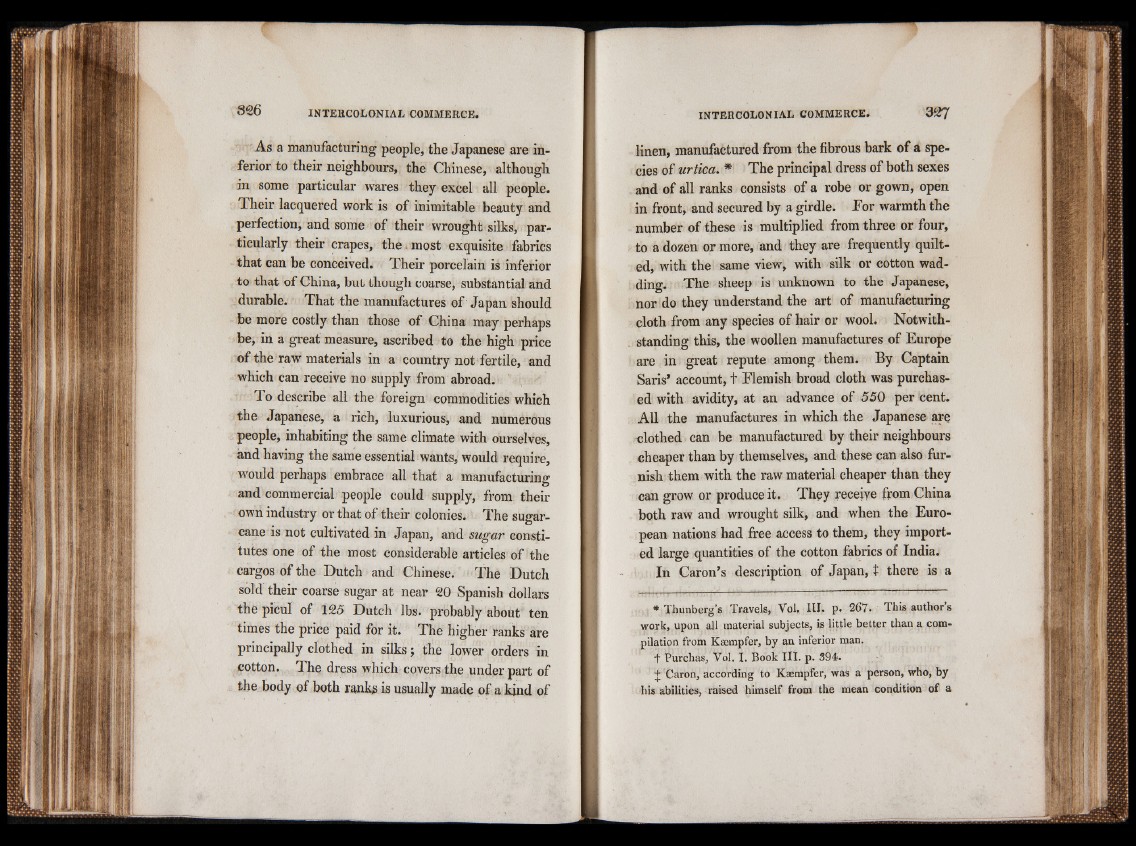
As a manufacturing people, the Japanese are inferior
to their neighbours, the Chinese, although
in some particular wares they excel all people.
Their lacquered work is of inimitable beauty and
perfection, and some of their wrought silks, particularly
their crapes, the. most exquisite fabrics
that can be conceived. Their porcelain is inferior
to that of China, but though coarse, substantial and
durable. That the manufactures of Japan should
be more costly than those of China may perhaps
be, in a great measure, ascribed to the high price
of the raw materials in a country not fertile, and
which can receive no supply from abroad.
To describe all the foreign commodities which
the Japanese, a rich, luxurious, and numerous
people, inhabiting the same climate with ourselves,
and having the same essential wants, would require,
would perhaps embrace all that a manufacturing
and commercial people could supply, from their
own industry or that of their colonies. The sugarcane
is not cultivated in Japan, and sugar constitutes
one of the most considerable articles of the
cargos of the Dutch and Chinese. The Dutch
sold their coarse sugar at near 20 Spanish dollars
the picul of 125 Dutch lbs. probably about ten
times the price paid for it. The higher ranks are
principally clothed in silks; the lower orders in
cotton. The dress which covers the under part of
the body of both rank*» is usually made of a kind of
linen, manufactured from the fibrous bark of a species
of urtica. * The principal dress of both sexes
and of all ranks consists of a robe or gown, open
in front, and secured by a girdle. Tor warmth the
number of these is multiplied from three or four,
to a dozen or more, and they are frequently quilted,
with the same view, with silk or cotton wadding.
The sheep is unknown to the Japanese,
nor do they understand the art of manufacturing
cloth from any species of hair or wool. Notwithstanding
this, the woollen manufactures of Europe
are in great repute among them. By Captain
Saris’ account, t Flemish broad cloth was purchased
with avidity, at an advance of 550 per cent.
AH the manufactures in which the Japanese are
clothed can be manufactured by their neighbours
cheaper than by themselves, and these can also furnish
them with the raw material cheaper than they
can grow or produce it. They receiye from China
both raw and wrought silk, and when the European
nations had free access to them, they imported
large quantities of the cotton fabrics of India.
In Caron’s description of Japan, t there is a
* Thunberg’s Travels, Vol. III. p. 267. This authors
work, upon all material subjects, is little better than a compilation
from Kæmpfer, by an inferior man.
+ Purchas, Vol. I. Book III. p. 394.
+ Caron, according to Kæmpfer, was a person, who, by
his abilities, raised himself from the mean condition of a